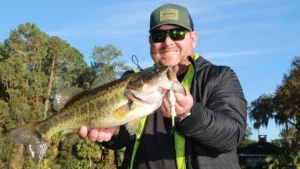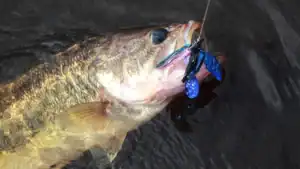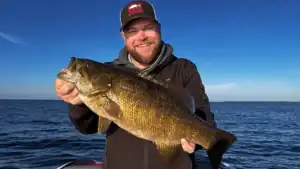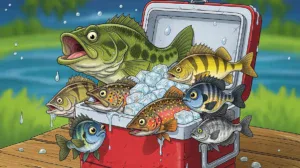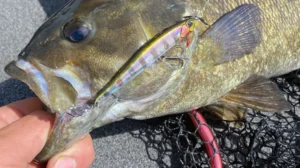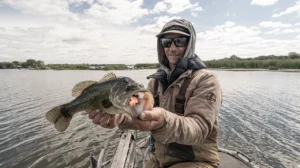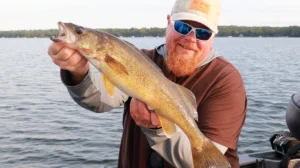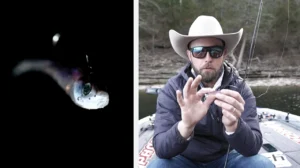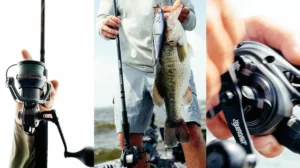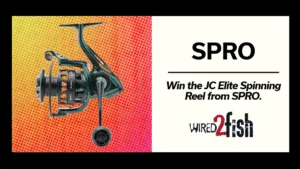When the first cool breeze of fall cuts across the lake, and the leaves start to drop, you can almost feel the bass waking up. After a long summer of sluggish days spent hugging deeper water, fall is the time when bass turn on the feedbag. Most anglers know how to catch bass in these temperatures, if they can find them. They sense winter creeping in, and just like deer putting on weight for the cold months ahead, bass go into a full-blown feeding mode.
For fishermen like you and me, that means some of the best action of the year — if you know how to read the conditions, locate the fish, and present the right bait. I’ll walk you through how bass behave in the fall, where you can expect to find them, and which techniques work best to put fish in the boat.
Understanding Bass Behavior In The Fall
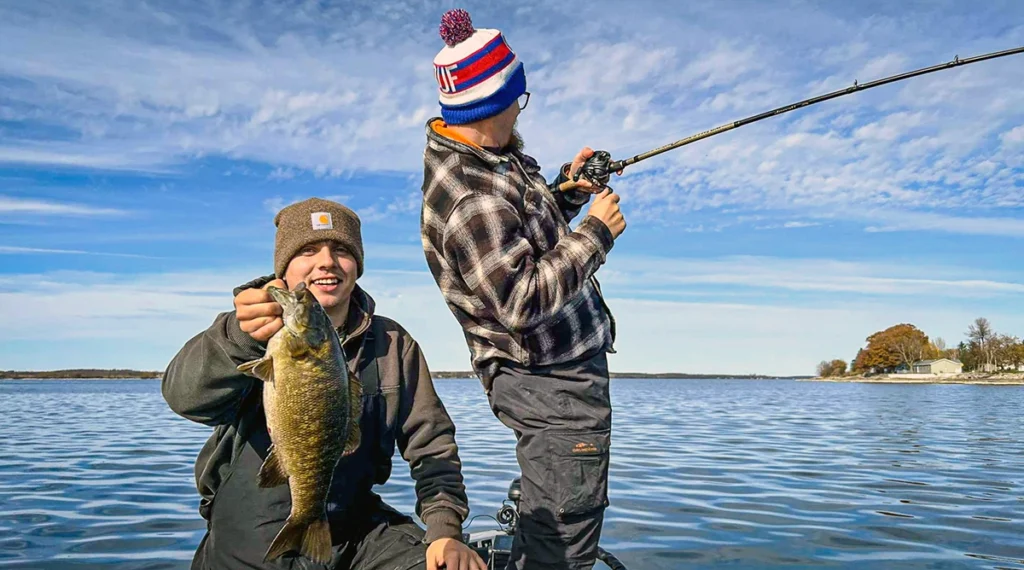
To catch bass consistently in the fall, you need to understand the conditions and environmental factors. Bass are creatures of habit, and their behavior in this season is mainly driven by three factors. Those are food, water temperature, and movement.
The Baitfish Connection
In most lakes and rivers, shad, herring and other baitfish make expansive movements in the fall. When the water cools into the 60s, baitfish start to migrate into the backs of creeks, coves, and shallow flats. Bass follow them like it’s their job. Without the baitfish, the bass won’t be able to feed up for the winter. Wherever the baitfish go, the bass are right behind them, picking off stragglers whenever they can.
That’s why fall fishing often feels like a feast or famine. You might struggle for hours and then suddenly run into a school of bass crushing a bait ball. The trick is to cover water and locate those schools of bait, even if not every school of bait has fish on them. It takes time to isolate those baitfish schools, so be prepared to cover some water
Temperature and Oxygen
Cooler water brings more dissolved oxygen, which makes bass more active. In the summer, bass hide in deep, shady, oxygen-rich zones. But in fall, most bodies of water flip and turn over. That means the water temperature is mixed and should be the same throughout the entire water column. Bass should be very comfortable roaming shallows, chasing bait, and feeding aggressively throughout the day, as well as being in possibly every depth throughout the waterbody.
Transition Points
Fall is also about fish movement. Bass are transitioning from deep summer haunts to shallow fall feeding grounds, and they’ll stage on points, ledges, and channel swings along the way. Think of these spots like rest stops on a highway. They’re natural ambush zones where bass wait for passing schools of baitfish so they can come out and attack. These are great spots to start when picking apart a lake in the fall.
Where To Find Bass In The Fall
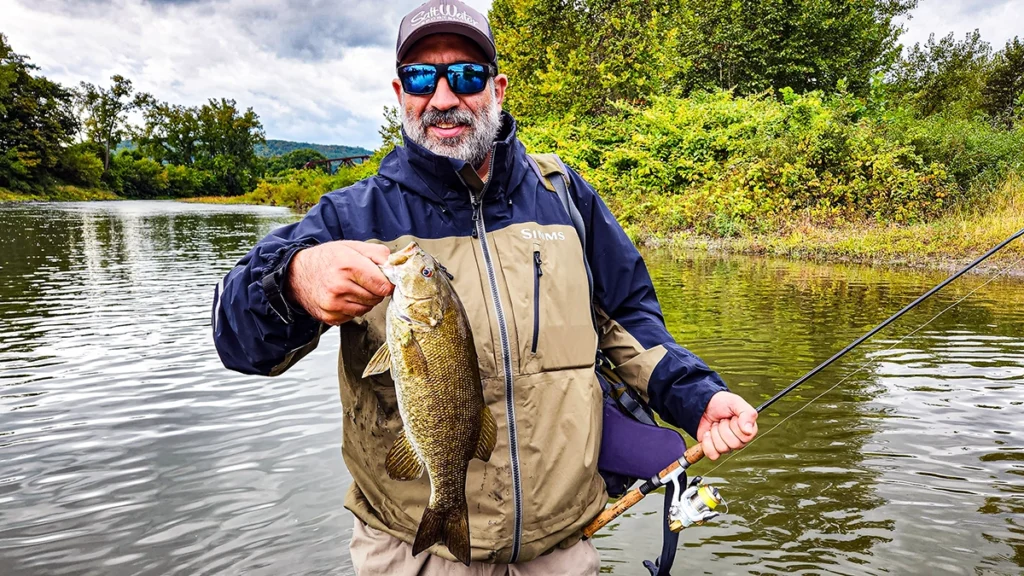
Now that we know why bass move in the fall, let’s talk about where you should look for them. There are specific places to dig into in the fall that hold more bass than other times during the year. Here are some starting spots to look for when you get to the lake on a cool fall day.
Main Lake Points and Secondary Points
Early in fall, bass often set up on the main lake and secondary points leading into creeks and coves. These are ambush spots where they can pin baitfish as they travel to the backs of these coves. If you graph around a point and see clouds of bait, you’re in business. Look for boulders and hard-defined weed edges on these points as these are key locations where bass will sit.
Creek Channels and Backs of Coves
As water cools into the 60s, baitfish push farther back into these pockets. Bass follow them into shallow creek arms, ditches, and channels. Sometimes you’ll find schools of busting bait in just a few feet of water with bass hot on their tail. This can make for some exciting, fast-paced action that could make or break a day of fishing.
Shallow Flats
Bass of both species will cruise large, expansive flats to feed on in the fall. Especially flats with lots of cover. Rock veins, grass edges, and stumps in the shallows are prime areas once bass push all the way onto these flats. These spots give bass a place to ambush baitfish that wander too close to cover. Sometimes bass can be stacked around small pieces of isolated cover, especially in lakes with little to no cover. Even manmade objects on shallow flats, like tires and concrete blocks, can hold lots of fish.
Wind Driven Banks
Don’t overlook the wind. Wind can be the biggest player in the fall when the feed bag is on. Wind blows plankton, which attracts baitfish, which attracts bass. A windy point or bank can be one of the hottest fall patterns out there. Similarly, if you’re fishing a river, any current break or seam where bait collects will hold fish.
Fall Bass Fishing Lures and Techniques
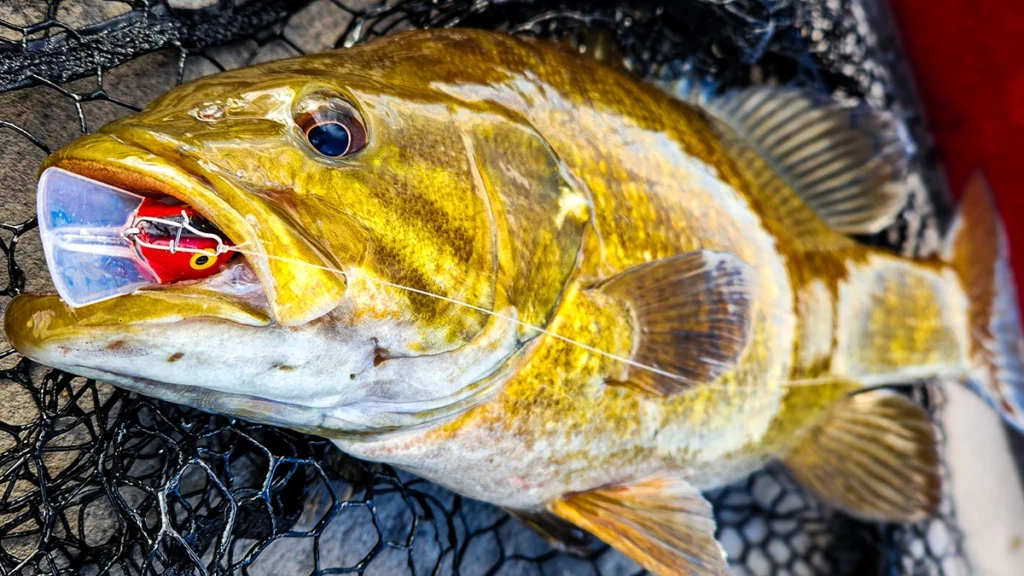
Bass during the fall can be very aggressive, but that doesn’t mean they’ll eat just anything. You need to match the mood of the fish and the type of forage they’re keying in on. Here are some proven baits and how to fish them in the fall.
The Umbrella Rig
In the fall, there is nothing that matches the hatch of a school of baitfish better than an umbrella rig. Its flash, vibration and motion through the water makes it the best baitfish school imitator on the market today. Please be sure to check with your local state regulations to see how many baits or hook points you can have on each bait. Certain states have mixed laws on how many arms or points can be used at one time
The key to working an umbrella rig is making the rig flex and flash. If you ever watch a school of baitfish in the water, they never swim straight. They are constantly darting and swimming around erratically. When you cast that umbrella rig, you’ll want to “flex” the rig with your reel. Flexing is when you make one or two revolutions of the reel handle to pop the rig and flex it to make it look real. You’ll also want rigs with a lot of flash to create more flash and vibration. The two best on the market that I’ve found are the YUM Flash Mob Jr. and the Brown Dog Tackle Umbrella Rig.
Crankbaits
Whether its squarebills, deep divers or round lipped, crankbaits are a fall staple. Crankbaits are supposed to imitate a fleeing baitfish that has strayed from the school. Squarebills shine in shallow creeks and around cover, while medium and deep divers are perfect for points and ambush spots. The wobble, flash and variety of baitfish patterns most crankbaits come in will ensure a perfect option for you. The best benefit of fishing a crankbait in the fall is you can fish it fast and you can cover a lot of water quickly.
I tend to look for crankbaits that are perfect all around baits that are proven to get bit under all circumstances. For me, the Rapala DT Series of baits do just that. They come in a variety of colors and sizes to match any baitfish or forage pattern as well as a balsa wood construction that gives them a great action in the water, especially in the fall when water is cooler.
Vary up your retrieve speeds with all crankbaits. The more change and structure-bouncing a crankbait has, the more bites it will draw from hunger, anger, or aggression.
Spinnerbaits
Another great baitfish imitator is a spinnerbait. With those big flashy blades, a bait like that throws off a lot of vibration, causing bass in the fall to go nuts! It’s a tough bait to beat in the fall, especially when the wind is howling and fishing up shallow. The flash of the blades mimics baitfish, and the vibration helps fish track through the water.
Depending on the water depth and cover type will determine your retrieve speed. When fishing deeper around rock or grass, you’ll want to slow roll your bait to just tick the top of the cover. If you’re up shallow, you’ll want to burn the bait to skim the surface and bang into every piece of available cover around. For an all around spinnerbait to burn and slow roll, I am a huge fan of the Bassman TW Series as it’s perfect for both situations to give off a lot of vibration and flash that drive bass nuts.
Jerkbaits
As water dips toward the 60s, jerkbaits can become deadly. More known for being used in the spring, they also have their time and place in the fall. The erratic, darting action mimics dying baitfish, which bass find irresistible. Remember, the more erratic the bait, usually the more bites you get. But, as the water temps get colder, your retrieve speed should be slower. A jerkbait can be a great tool to find and cover shallow water at a fast rate. When that bait is darting around at a fast rate, it will trigger more reaction strikes than you’ll know what to do with.
You’ll want to work a jerkbait with sharp twitches and pauses. The goal is to mimic a dying bait fish. Even in the warmer temps of early fall, having some sort of short pause in your retrieve could make all the difference. The best jerkbait that I’ve found to be a great combination of fast and slow retrieves is a Rapala X-Rap. This bait has been proven year after year to produce big bites in the fall for both species of bass, especially in shallow water. Vary your retrieve speed and lengths of pauses for the best results.
Football Jigs
Even though fall bass are aggressive, sometimes they hunker down around cover and won’t chase moving baits. That’s when a jig comes into play, more importantly a football jig. But why a football jig? Isn’t the main deal to be on baitfish in the fall? Yes, baitfish are the key factor, but that doesn’t mean a football jig can’t be used. In fact, I’m using these jigs to imitate baitfish, especially as the water cools in the fall and the bait starts to move closer to the bottom. It could be perch, bluegills, or even herring, all prey species move to the bottom at some point. A football jig is an excellent player when the bait is close to the bottom. I get all of my footballs tied up from my good friend Tristen who owns and custom jig tyer of T’s Tackle NY, but there’s plenty of other football jigs on the market, like a Keitech Model 2 Football Jig or a Beast Coast O.W. Sniper.
The main key is the trailer. When imitating baitfish, you want a trailer with a straight tail to imitate that baitfish profile on the bottom. When bass are keying in on gobies, I usually go to a ned style trailer, like a Berkley Maxscent Lil General. When bass are feeding on perch, or other bait towards the bottom, a little swimbait works perfectly, like a Strike King Rage swimmer.
Top Tips for Fall Bass Success
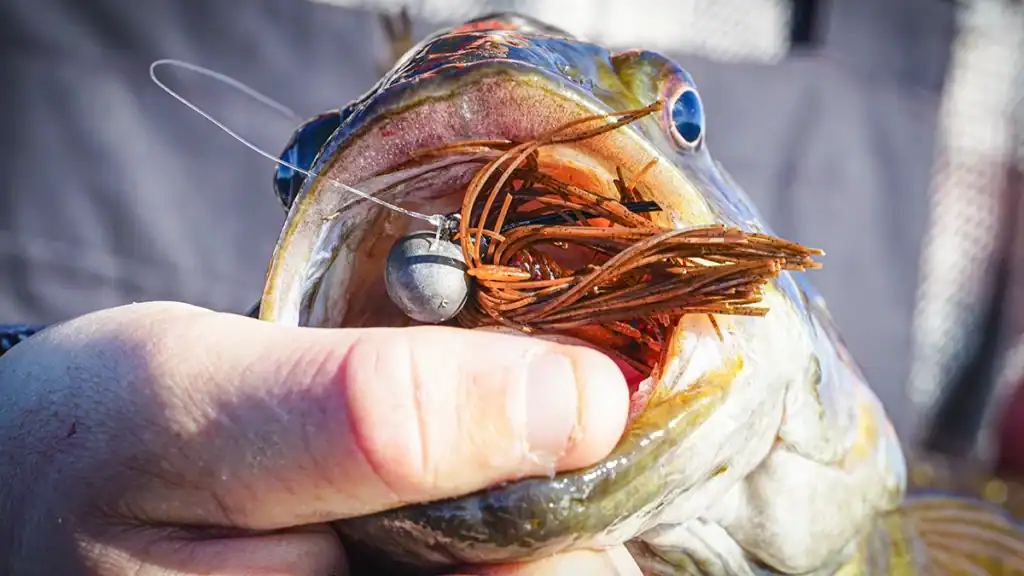
Remember, it’s not always easy to find the fish in the fall, let alone let alone get them to bite. Here is a short list I put together on some of the top tips I’ve learned about fall fishing. Be sure to take all these factors into consideration throughout the fall. They are super important.
- Follow the Bait: This is the golden rule of fall fishing. If you’re not seeing baitfish, keep moving. Bass rarely stray far from their food source in this season.
- Stay Mobile: Don’t camp on one spot too long. Fall fishing is about covering water until you locate an active school. Once you find them, you might catch 10 to 20 fish in a hurry.
- Match the Hatch: Pay attention to baitfish size. If bass are feeding on tiny baitfish, you may need to downsize to a small crankbait, finesse swimbait, or even a little grub.
- Understand How to Use Your Electronics: Modern sonar and forward-facing units make finding bait schools much easier. Spend time graphing points and creek channels before making casts.
- Take Advantage of Feeding Windows: Fall bass can feed all day, but there are still peak times. Early morning, late afternoon, and right before a front moves in. Be ready when the window opens.
Challenges Of Fall Fishing

Fall can be one of the most rewarding seasons, but it also frustrates a lot of anglers. The number one challenge is locating fish. Unlike summer, where you can target deep brush or humps, bass in the fall are nomadic and constantly moving with bait. You may fish empty water for hours and then stumble into a school that makes the whole trip worthwhile.
Another challenge is the “junk fishing” factor. Because bass species move so much and focus on different areas in a day, you might have to throw multiple lures in a single trip. Don’t be afraid to switch things up and try something new. This is the season for versatility and opportunity.
Fall bass fishing is all about energy, movement, and opportunity. The bass are feeding heavily, the water is alive with baitfish, and conditions change daily. For a fisherman, that means plenty of challenges, but also some of the best action of the year.
If you remember one thing, find the bait, and you’ll find the bass. From points to creeks, windy banks to shallow flats, bass are always hunting food in the fall. Match your presentation to their mood, stay mobile, and enjoy the ride.
For me, there’s nothing better than watching a school of bass erupt on an Alewife ball under a crimson autumn sky. That’s fall fishing in a nutshell. Wild, unpredictable, and absolutely addictive. So grab your rods, pack your tackle box, and hit the water. Fall won’t last forever, and the bass are waiting to get fat and happy before the real cold sets in.


